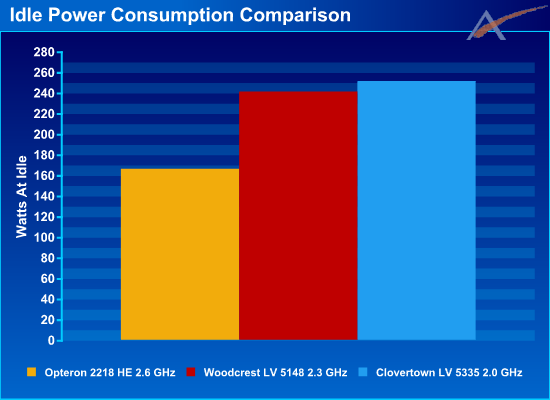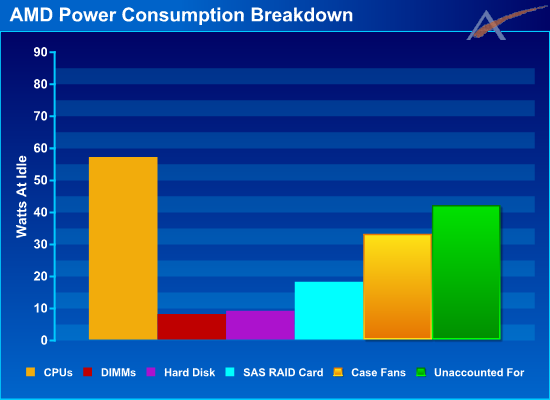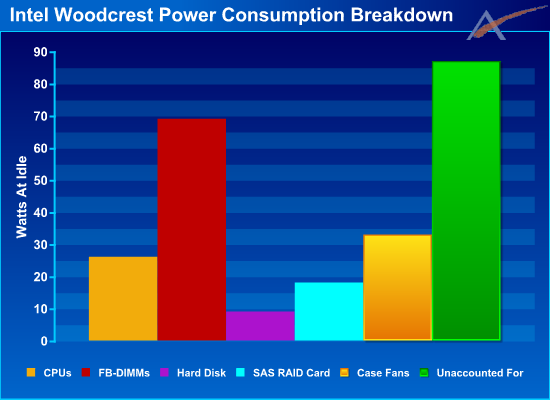Low Power Server CPU Redux: Quad-Core Comes to Play
by Jason Clark & Ross Whitehead on September 13, 2007 6:05 AM EST- Posted in
- IT Computing
Benchmarking Low Voltage
Since this article is focused on low power parts and that market is mostly focused on Performance/Watt, we decided we would only report results with all power management features enabled. To configure our servers with all power management features on, we perform the following:
On Intel
In the BIOS ensure that Thermal Management is On/Enabled, C1 Enhanced Mode is On/Enabled, and EIST Support is On/Enabled.
On AMD
In the BIOS ensure that PowerNow is On/Enabled. Additionally, you must install the Processor Driver, from AMD, in your OS.
For both platforms you must also set the Power Options in Control Panel to "Server Balanced Processor Power and Performance".
For details about the impact that the Power Management features had on a system at idle please see our previous article. With all Power Management features turned on we recorded idle power usage for all three systems.

We see that AMD has the lowest idle power consumption. Intel's Woodcrest system uses approximately 41% more power at idle, and the Clovertown system uses approximately 51% more power at idle. The Clovertown system only uses approximately 4% more power at idle than the Woodcrest system, which is not bad considering it has twice as many CPU cores.
During the testing, we often speculate about where all the power goes. We attempted to find out by measuring power consumption of the entire system at idle, then removing a component and re-measuring the power consumption. The difference in power can be attributed to the removed component. This is not a perfect way to determine component power requirements, but it does provide some general guidance as to where all of the power goes. The results are very interesting:

In the AMD system we see that the bulk of the power is consumed by the idle CPUs. Overlooking the "Unaccounted For", the next biggest consumer is the five case fans, followed by the SAS RAID Card. The "Unaccounted For" is everything which is not listed, including the inefficiency of the power supply and the motherboard and chipset.

In the Intel Woodcrest system we see that the CPUs require significantly less power than the AMD CPUs, 54% less to be exact. On the other hand the FB-DIMMs require 862% more power than the AMD DIMMs. (Yikes!) Also, the "Unaccounted For" is twice as high on the Intel system as the AMD system. Keep in mind both of these systems have identical power supplies, so the efficiency is roughly the same.

The Intel Clovertown system is identical to the Woodcrest system except for the CPUs, which require approximately 4% more power at idle.
Choosing the contenders
In previous articles, we've been asked to explain why we chose the parts we did for an article. For this article we used the latest low voltage quad-core parts from Intel and the latest low power dual-core parts from AMD. The first question that may come to mind is, "Why are you comparing a quad-core part with a dual-core part?". The answer is quite simple: for Intel the two quad-core / dual-core parts we're comparing cost about the same, so while the parts we are comparing aren't equal in terms of the number of Cores, they are equal in terms of price. On the AMD side of things, the CPU price is once again similar, but other than the just-released Barcelona there are no quad-core AMD offerings. Since testing for this article began over a month ago, including Barcelona wasn't an option at the time.
Since this article is focused on low power parts and that market is mostly focused on Performance/Watt, we decided we would only report results with all power management features enabled. To configure our servers with all power management features on, we perform the following:
On Intel
In the BIOS ensure that Thermal Management is On/Enabled, C1 Enhanced Mode is On/Enabled, and EIST Support is On/Enabled.
On AMD
In the BIOS ensure that PowerNow is On/Enabled. Additionally, you must install the Processor Driver, from AMD, in your OS.
For both platforms you must also set the Power Options in Control Panel to "Server Balanced Processor Power and Performance".
For details about the impact that the Power Management features had on a system at idle please see our previous article. With all Power Management features turned on we recorded idle power usage for all three systems.

We see that AMD has the lowest idle power consumption. Intel's Woodcrest system uses approximately 41% more power at idle, and the Clovertown system uses approximately 51% more power at idle. The Clovertown system only uses approximately 4% more power at idle than the Woodcrest system, which is not bad considering it has twice as many CPU cores.
During the testing, we often speculate about where all the power goes. We attempted to find out by measuring power consumption of the entire system at idle, then removing a component and re-measuring the power consumption. The difference in power can be attributed to the removed component. This is not a perfect way to determine component power requirements, but it does provide some general guidance as to where all of the power goes. The results are very interesting:

In the AMD system we see that the bulk of the power is consumed by the idle CPUs. Overlooking the "Unaccounted For", the next biggest consumer is the five case fans, followed by the SAS RAID Card. The "Unaccounted For" is everything which is not listed, including the inefficiency of the power supply and the motherboard and chipset.

In the Intel Woodcrest system we see that the CPUs require significantly less power than the AMD CPUs, 54% less to be exact. On the other hand the FB-DIMMs require 862% more power than the AMD DIMMs. (Yikes!) Also, the "Unaccounted For" is twice as high on the Intel system as the AMD system. Keep in mind both of these systems have identical power supplies, so the efficiency is roughly the same.

The Intel Clovertown system is identical to the Woodcrest system except for the CPUs, which require approximately 4% more power at idle.
Choosing the contenders
In previous articles, we've been asked to explain why we chose the parts we did for an article. For this article we used the latest low voltage quad-core parts from Intel and the latest low power dual-core parts from AMD. The first question that may come to mind is, "Why are you comparing a quad-core part with a dual-core part?". The answer is quite simple: for Intel the two quad-core / dual-core parts we're comparing cost about the same, so while the parts we are comparing aren't equal in terms of the number of Cores, they are equal in terms of price. On the AMD side of things, the CPU price is once again similar, but other than the just-released Barcelona there are no quad-core AMD offerings. Since testing for this article began over a month ago, including Barcelona wasn't an option at the time.










36 Comments
View All Comments
Justin Case - Saturday, September 15, 2007 - link
I would rather have an article called "quad core coming to play" that actually tests quad-core CPUs from both major manufacturers, and not quad core from one versus dual-core from the other. This article would have made perfect sense one week after Intel's quad-core Xeons were launched. Not one week after Barcelona was launched.As other have pointe out, this article is obsolete on arrival. People choosing between dual-core Opterons and quad-core Xeons have made their decision a long time ago. Anyone who still hasn't is obviously waiting for quad-core Opteron numbers.
If three days (actually seven, but let's pretend your Barcelona systems were busy 24/7 during the first four) weren't enough to run a single "performance-per-watt" server benchmark on both systems (or on a dual-core vs. quad-core Opteron), and present a comparison, then maybe it would have made more sense to wait another day or two, and release a relevant article instead of one that looks more like a (bad) Intel PR exercise, timed just to coincide with the lanuch of faster CPUs from the competition.
Griswold - Friday, September 14, 2007 - link
Funny link to the "Intel Resource Center" at the end of the article. Could also just call it the "AnandTech Intel Filter sponsored by Intel" for it only presents articles related to Intel.No, I'm not complaining. Just pointing out something mildly amusing, because I havent seen such sponsoring yet (nor did I really expect AT to accept it).
Goty - Thursday, September 13, 2007 - link
Since it appears that AMD made good on its work to deliver Barcelona chips that don't consume any more power than their dual-core Opteron counterparts, I'm thinking that Intel is either going to have to make some significant speed improvements with Harpertown or lower the power consumed by the platform somewhat to beat AMD in the performance/watt category. The move to 45nm will certainly help in that area (barring another Prescott SNAFU), but it's still going to be interesting.cmdrdredd - Thursday, September 13, 2007 - link
Performance per watt? Why do people keep saying that...to most people that really matters little in the grand picture. They want the best performance at a certain pricepoint. Who counts wattage when making a choice in CPU or any type of hardware not including a PSU. If one is faster at a certain price you're ready to pay then that's the one you'll get. Performance per watt is something people say when their choice is slower.smitty3268 - Friday, September 14, 2007 - link
You're right that people with a couple servers running don't really care too much, unless it's extremely bad like Prescott was. However, there is a reason that both Intel and AMD have been hyping efficiency and coming out with special low-power products. It's because the data centers that are trying to cram 200 computers into a single room without overloading the buildings power system can get more computing power given their limited resources. For this market price almost doesn't matter, as it costs much more to get a new building then it does to pay more to get lower power efficient cpus.Goty - Thursday, September 13, 2007 - link
Everything you're saying is pretty much true... until you actually start talking about the market sectors these parts are aimed at.You have to get out of your tiny little mindset that all new product releases are aimed at enthusiasts and consider that there is more than one market out there.
In the server and HPC spaces, performance per watt is very important because lower power consumption allows for greater density (in most cases). Who cares if one architecture is 15% faster per-core-per-clock when I can fit 25% more of the slower architecture into the same power and space envelope?
mattsaccount - Thursday, September 13, 2007 - link
"What, no Barcelona?"Frags - Saturday, September 15, 2007 - link
Barcelona is being shipped to OEMs and is not available to customers regardless of what AMD says. Are you suprised that there is no Barcelona Benchmarks? There hasn't been any for months and even weeks before the launch. AMD is the only one to blame for no 3rd party benchmarks as they don't offer press kits ahead of time for 3rd party testing. If they have, it's a rarity. For now it's back to the AMD slideshows.Proteusza - Friday, September 14, 2007 - link
Their decision was sound from a business point of view. Native quad core is difficult, it costs a lot. AMD was months late to market with their quad core, most likely in part due to it.
Yet, with AMD's native quad core CPU already out, I fail to see why you say that Intel decision was the right one. Had you posted this article a month ago, yes I would have agreed that Intel's quad cores were running rings around AMD, and despite their higher power efficiency in some cases, Intel was winning over all, especially in higher loads. But now, the situation is different - AMD has their own native quad core, which in all likelihood is more energy efficient than the Intel. Thus, your conclusion isnt valid - Intel's choice was right at the time, because AMD could not compete, but now they can, and now its quad core vs quad core, and the fact that AMD's quad core is a single die gives it a small but significant advantage.
Why did you not benchmark the Barcelona chip? I'm aware its not really available in volume right now, but...
coolme - Monday, September 17, 2007 - link
Intel having quad-core before AMD did give them the upper hand, because native quad-core as it turns out, only gave a small advantage to AMD. Although it doesn't seem like AMD is winning this race with barcelona, they need to stop their stubborness and accept the fact that MXM design is the way to go and start pumping out octa-cores before intel does. It's the only way amd can regain their crown. I mean the fact that native quad-core means low yields is already costing them millions, they need to accept the fact that MXM is a more efficient solution for making processors.